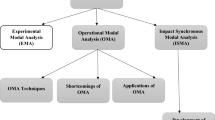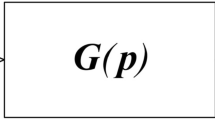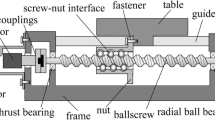Abstract
In the field of CNC milling, chatter has been a hot research topic, which is related to machining quality, precision and cost. Stability lobe diagram (SLD) reflects the vibration of the machining system under different process parameters and cutter axis vectors that is significant for optimization. The accurate dynamic characteristics of the machining system is the prerequisite for stability analysis. Finite element simulation is mainly aimed at small diameter cutter system, and accuracy is poor. The most widely used method is hammer test, but the equipment is expensive, the operation is too professional and it cannot reflect the dynamic characteristics of the machining system in working status. This paper proposes an undetermined coefficient method for the general cutter system to identify the modal parameters, that are the natural frequency, stiffness and damping ratio, just based on the very simple experiment of three-axis half-immersion milling in horizontal plane. Firstly, considering the exact in-cut cutting edge and the instantaneous cutting force coefficient corresponding to the axial factor and the chip thickness, the dynamic model of three-axis milling machining for the general cutter is established. Secondly, two implicit conditions of stable critical speed and cutting depth are derived based on feedback control theory in the frequency domain. Thirdly, the two sets of critical cutting depth and the chatter frequency under arbitrary speeds are obtained by using the dichotomy. With the method proposed in this paper, one of the two is used to solve a series of modal parameter sets, and the other of the two is used to extract the optimal modal parameters in the modal parameter sets. Finally, taking the identified modal parameters as known conditions to search the points one by one in the two-dimensional space composed of the rotational speed and the cutting depth, and judge whether it meets the critical conditions. SLD can be obtained by connecting the points that satisfy critical conditions together. Based on the previous experiment of flat-end cutter, it verified the feasibility of the modal parameter identification method in the paper. In the designed three-axis milling experiment of the ball-end cutter, the in-cut cutting edge simulation and the cutting force coefficient identification were carried out, and the modal parameters of the cutter system were also obtained successfully. The plotted lobe diagram was verified by the spectrum analysis result of the vibration signal collected by the acceleration sensor.
















Similar content being viewed by others
References
Altintas, Y., & Ber, A. A. (2012). Manufacturing Automation: Metal Cutting Mechanics, Machine Tool Vibrations, and CNC Design. New York: Cambridge University Press.
Altintaş, Y., & Budak, E. (1995). Analytical prediction of stability lobes in milling. Cirp, 44(1), 357–362.
Altintas, Y., & Weck, M. (2004). Chatter stability of metal cutting and grinding. CIRP Annals-Manufacturing Technology, 53(2), 619–642.
Dikshit, M. K., Puri, A. B., & Maity, A. (2017). Chatter and dynamic cutting force prediction in high-speed ball end milling. Machining Science & Technology, 21(2), 291–312.
Gok, A. (2015). A new approach to minimization of the surface roughness and cutting force via fuzzy TOPSIS, multi-objective grey design and RSA. Measurement, 70, 100–109.
Gok, A., Gök, K., Bilgin, M. B., & Alkan, M. A. (2017). Effects of cutting parameters and tool-path strategies on tool acceleration in ball-end milling. Materials and Technology, 51(6), 957–965.
Gok, A., Gologlu, C., & Demirci, H. I. (2013). Cutting parameter and tool path style effects on cutting force and tool deflection in machining of convex and concave inclined surfaces. International Journal of Advanced Manufacturing Technology, 69(5–8), 1063–1078.
Gok, K., Neseli, E. S., & Kisioglu, Y. (2014). Failure analysis of support during profile cutting process using horizontal milling machine. The International Journal of Advanced Manufacturing Technology, 70(5–8), 1169–1179.
Guo, M. L., Wei, Z. C., Wang, M. J., Li, S. Q., & Liu, S. X. (2018). An identification model of cutting force coefficients for five-axis ball-end milling. The International Journal of Advanced Manufacturing Technology, 99(1–4), 937–949.
Liu, A. M., Cheng, P., & Liu, J. Z. (2007). Detection of chatter and prediction of stable cutting zones in high-speed milling. Journal of Mechanical Engineering, 43(1), 164–169.
Merdol, S. D., & Altintas, Y. (2004). Mechanics and dynamics of serrated cylindrical and tapered end mills. Journal of Manufacturing Science & Engineering, 126(2), 317–326.
Omid, Y., Andrey, B., & Joshua, T. (2020). Point-by-point prediction of cutting force in 3-axis CNC milling machines through voxel framework in digital manufacturing. Journal of Intelligent Manufacturing, 31(1), 215–226.
Ozkirimli, O., Tunc, L. T., & Budak, E. (2016). Generalized model for dynamics and stability of multi-Axis milling with complex Tool geometries. Journal of Materials Processing Tech, 238, 446–458.
Özşahin, O., Budak, E., & Özgüven, H. N. (2015). In-process tool point FRF identification under operational conditions using inverse stability solution. International Journal of Machine Tools and Manufacture, 89, 64–73.
Pour, M., & Torabizadeh, M. A. (2016). Improved prediction of stability lobes in milling process using time series analysis. Journal of Intelligent Manufacturing, 27(3), 665–677.
Schmitz, T. L., & Smith, K. S. (2009). Machining dynamics. London: Springer.
Suzuki, N., Kurata, Y., Kato, T., Hino, R., & Shamoto, E. (2012). Identification of transfer function by inverse analysis of self-excited chatter vibration in milling operations. Precision Engineering, 36(4), 568–575.
Tangjitsitcharoen, S., Saksri, T., & Ratanakuakangwan, S. (2015). Advance in chatter detection in ball end milling process by utilizing wavelet transform. Journal of Intelligent Manufacturing, 26(3), 485–499.
Tarng, Y. S., & Chen, M. C. (1994). An intelligent sensor for detection of milling chatter. Journal of Intelligent Manufacturing, 5(3), 193–200.
Tlusty, J., & Polacek, M. (1963). The stability of the machine tool against self-excited vibration in machining. In ASME production engineering research conference (pp. 454–465).
Vaishnav, S., Agarwal, A., & Desai, K. A. (2019). Machine learning-based instantaneous cutting force model for end milling operation. Journal of Intelligent Manufacturing.
Wan, M., Wang, Y. T., Zhang, W. H., Yang, Y., & Dang, J. W. (2011). Prediction of chatter stability for multiple-delay milling system under different cutting force models. International Journal of Machine Tools & Manufacture, 51(4), 281–295.
Wei, Z. C., Guo, M. L., Wang, M. J., Li, S. Q., & Liu, S. X. (2018). Prediction of cutting force in five-axis flat-end milling. International Journal of Advanced Manufacturing Technology, 96(1–4), 137–152.
Wojciechowski, S. (2015). The estimation of cutting forces and specific force coefficients during finishing ball end milling of inclined surfaces. International Journal of Machine Tools & Manufacture, 89, 110–123.
Wu, S., Yang, L., Liu, X. L., Zheng, M. L., & Li, R. Y. (2016). Effects of curvature characteristics of sculptured surface on chatter stability for die milling. International Journal of Advanced Manufacturing Technology, 89(9–12), 1–14.
Yang, Y., Zhang, W. H., Wan, M., & Ma, Y. C. (2013). A solid trimming method to extract cutter–workpiece engagement maps for multi-axis milling. International Journal of Advanced Manufacturing Technology, 68(9–12), 2801–2813.
Yılmaz, E. E., Budak, E., & Özgüven, H. N. (2016). Modeling and measurement of micro end mill dynamics using inverse stability approach. Procedia Cirp, 46, 242–245.
Zhang, X., Zhang, J., Pang, B., Wu, D. D., Zheng, X., & Zhao, W. (2016). An efficient approach for milling dynamics modeling and analysis with varying time delay and cutter runout effect. International Journal of Advanced Manufacturing Technology, 87(9–12), 3378–3388.
Author information
Authors and Affiliations
Corresponding author
Additional information
Publisher's Note
Springer Nature remains neutral with regard to jurisdictional claims in published maps and institutional affiliations.
Rights and permissions
About this article
Cite this article
Guo, M., Wei, Z., Wang, M. et al. Modal parameter identification of general cutter based on milling stability theory. J Intell Manuf 32, 221–235 (2021). https://doi.org/10.1007/s10845-020-01569-y
Received:
Accepted:
Published:
Issue Date:
DOI: https://doi.org/10.1007/s10845-020-01569-y




